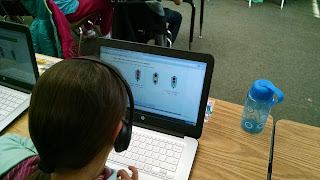In math this week we began our unit on Data and Graphing. Each day this week we created a different graph. As a class we discovered you have to have a specific survey or set of questions in mind and then you can gather the data. After gathering the data and marking all responses with tally marks, we organized the data and counted up the total tallies in each category. Once our data was organized, we had to find a way to display the information. As a whole class we talked about the different components of graphs: title, labels for each of the sides, the numbers, the categories, and most importantly the bars that make up the data on the graph. The students had a chance to view different types of graphs and we discussed why we have graphs. Later in the week, the students were in small groups and created their own graphs from the very beginning. Each student had a specific job: gather data, organized data, or display data. The graphs turned out wonderful. One group did a graph on favorite types of candies; another did a graph on favorite holidays; and the last group did a graph on favorite ice cream flavors. Let's take a look at the data!
And below, we have the creative process of how these graphs were put together. Lots of teamwork!


On Tuesday of this week, we also made a real-life graph using our shoes. We were able to determine if there were more people wearing tie-shoes or slip-on/boot shoes. Check out our shoe graph!
The other part of our graphing unit that we focused on this week was being able to analyze the data. The students had to figure out which had the most and least in each graph, along with other type of analytical questions. As part of their group graph, each group created 5 analytical questions of their own that they asked the class. We learned that analyzing a graph is a very critical piece of graphing.
In science, we didn't start a new unit, but we were building upon a concept that we had started before winter break. We have been talking about erosion and various changes that can happen to the land. Some of these changes are slow (such as erosion) and others occur very quickly (such as an earthquake). This week we were exploring erosion of land in a comparison of wind and water changes. In our small scale experiment with sand towers, we found that it takes a lot of wind and water erosion to make any drastic changes to the land. In each group we had a "wind person", a "water person", a measurer, and a materials manager. The class had a great time with putting up their sand castles to observe the erosion effects.
We finished up our second unit of Digital Citizenship. I am very happy to say that the students seem to be very responsible and cooperative digital citizens so far. We have talked about different types of sites that are good for 2nd graders. Every time I introduce a new source or website to the class, I hear someone ask if it is a green site for them! I love knowing that they take digital citizenship so seriously!
Our week in class ended with some STEAM activities dealing with sound and how it is made and absorbed. In an attempt to quiet down the cafeteria area at lunch, the entire school is involved in a sound project as part of our STEAM curriculum. Each class is creating a sound board that will be hung in the cafeteria to help absorb some of the noise during lunch time. Before I had the class build the soundboard, I wanted them to have some background knowledge on sound. Today the class had a great time and got to explore sound on their own. We had three sound centers this afternoon: 1) Sounds from a Balloon, 2) Sounds of Metal (wire hanger), and 3) Sounds of Silverware. At each of the different centers, the students explored with how sound could be made using different objects and then make observations that corresponded to their investigations. I can easily tell you that the Balloon center was by far the favorite because there are so many sounds that can be created with a simple balloon. Although, the Sounds of Metal was fun for the kids too because one of the group discovered that with the wire hanger on a string, if you hold the string to your ear and have someone else hit the hanger --- only you can hear the sound and vibration of the metal hanger. Today was a great day of exploration and investigation involving sound.
As a class we had so much fun learning this week! I love seeing the discoveries that the students make and it is great to be exploring with these kids.




















































No comments:
Post a Comment